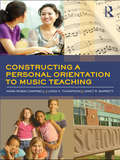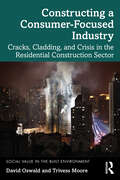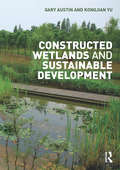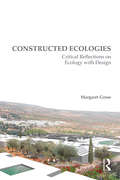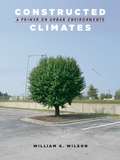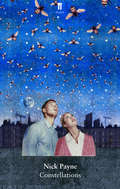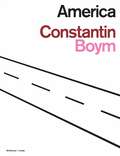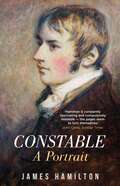- Table View
- List View
Constructing Building Enclosures: Architectural History, Technology and Poetics in the Postwar Era
by Clifton FordhamConstructing Building Enclosures investigates and interrogates tensions that arose between the disciplines of architecture and engineering as they wrestled with technology and building cultures that evolved to deliver structures in the modern era. At the center of this history are inventive architects, engineers and projects that did not settle for conventional solutions, technologies and methods. Comprised of thirteen original essays by interdisciplinary scholars, this collection offers a critical look at the development and the purpose of building technology within a design framework. Through two distinct sections, the contributions first challenge notions of the boundaries between architecture, engineering and construction. The authors then investigate twentieth-century building projects, exploring technological and aesthetic boundaries of postwar modernism and uncovering lessons relevant to enclosure design that are typically overlooked. Projects include Louis Kahn’s Weiss House, Minoru Yamasaki’s Science Center, Sigurd Lewerentz’s Chapel of Hope and more. An important read for students, educators and researchers within architectural history, construction history, building technology and design, this volume sets out to disrupt common assumptions of how we understand this history.
Constructing a Sense of Place: Architecture and the Zionist Discourse (Design and the Built Environment)
by Haim YacobiWhile it is widely recognized that architects and their architecture play a key role in constructing a sense of place, the inherent nexus between an architectural ideology and the production of national space and place has so far been neglected. Focusing on the Zionist ideology, this book brings together practising architects and academics to critically examine the role of architects, architecture and spatial practices as mediators between national ideology and the politicization of space. The book first of all sets out the wider context of theoretical debates concerning the role of architecture in the process of constructing a sense of place then divides into six main sections. The book not only provides an innovative new perspective on how the Israeli state had developed, but also sheds light on how architecture shapes national identity in any post-colonial and settler state.
Constructing a Sense of Place: Architecture and the Zionist Discourse (Design and the Built Environment)
by Haim YacobiWhile it is widely recognized that architects and their architecture play a key role in constructing a sense of place, the inherent nexus between an architectural ideology and the production of national space and place has so far been neglected. Focusing on the Zionist ideology, this book brings together practising architects and academics to critically examine the role of architects, architecture and spatial practices as mediators between national ideology and the politicization of space. The book first of all sets out the wider context of theoretical debates concerning the role of architecture in the process of constructing a sense of place then divides into six main sections. The book not only provides an innovative new perspective on how the Israeli state had developed, but also sheds light on how architecture shapes national identity in any post-colonial and settler state.
Constructing a Place of Critical Architecture in China: Intermediate Criticality in the Journal Time + Architecture
by Guanghui DingFor the past 30 years, The Chinese journal Time + Architecture (Shidai Jianzhu) has focused on publishing innovative and exploratory work by emerging architects based in private design firms who were committed to new material, theoretical and pedagogical practices. In doing so, this book argues that the journal has engaged in the presentation and production of a particular form of critical architecture - described as an ’intermediate criticality’ - as a response to the particular constraints of the Chinese cultural and political context. The journal’s publications displayed a ’dual critique’ - a resistant attitude to the dominant modes of commercial building practice, characterised by rapid and large-scale urban expansion, and an alternative publishing practice focusing on emerging, independent architectural practitioners through the active integration of theoretical debates, architectural projects, and criticisms. This dual critique is illustrated through a careful review and analysis of the history and programme of the journal. By showing how the work of emerging architects, including Yung Ho Chang, Wang Shu, Liu Jiakun and Urbanus, are situated within the context of the journal’s special thematic editions on experimental architecture, exhibition, group design, new urban space and professional system, the book assesses the contribution the journal has made to the emergence of a critical architecture in China, in the context of how it was articulated, debated, presented and perhaps even ’produced’ within the pages of the publication itself. The protagonists of critical architecture have endeavoured to construct an alternative mode of form and space with strong aesthetic and socio-political implications to the predominant production of architecture under the current Chinese socialist market economy. To rebel against certain forms of domination and suppression by capital and power is by no means to completely reject them; rather, it is to use thos
Constructing a Place of Critical Architecture in China: Intermediate Criticality in the Journal Time + Architecture
by Guanghui DingFor the past 30 years, The Chinese journal Time + Architecture (Shidai Jianzhu) has focused on publishing innovative and exploratory work by emerging architects based in private design firms who were committed to new material, theoretical and pedagogical practices. In doing so, this book argues that the journal has engaged in the presentation and production of a particular form of critical architecture - described as an ’intermediate criticality’ - as a response to the particular constraints of the Chinese cultural and political context. The journal’s publications displayed a ’dual critique’ - a resistant attitude to the dominant modes of commercial building practice, characterised by rapid and large-scale urban expansion, and an alternative publishing practice focusing on emerging, independent architectural practitioners through the active integration of theoretical debates, architectural projects, and criticisms. This dual critique is illustrated through a careful review and analysis of the history and programme of the journal. By showing how the work of emerging architects, including Yung Ho Chang, Wang Shu, Liu Jiakun and Urbanus, are situated within the context of the journal’s special thematic editions on experimental architecture, exhibition, group design, new urban space and professional system, the book assesses the contribution the journal has made to the emergence of a critical architecture in China, in the context of how it was articulated, debated, presented and perhaps even ’produced’ within the pages of the publication itself. The protagonists of critical architecture have endeavoured to construct an alternative mode of form and space with strong aesthetic and socio-political implications to the predominant production of architecture under the current Chinese socialist market economy. To rebel against certain forms of domination and suppression by capital and power is by no means to completely reject them; rather, it is to use thos
Constructing a Personal Orientation to Music Teaching
by Mark Robin Campbell Linda K Thompson Janet R. BarrettConstructing a Personal Orientation to Music Teaching promotes inquiry and reflection to facilitate teacher growth, lifelong learning and a disposition toward educational change. Strongly grounded in current theories and research in teacher education, the text engages readers in analyzing their own experiences in order to conceptualize the complexity of teaching; involves them in clarifying their reasons for seeking a career in teaching; supports their insights, questions, and reflections about their work; and promotes a reflective, critical attitude about schools in general as teachers are urged to think of themselves as change agents in school settings.
Constructing a Personal Orientation to Music Teaching
by Mark Robin Campbell Linda K Thompson Janet R. BarrettConstructing a Personal Orientation to Music Teaching promotes inquiry and reflection to facilitate teacher growth, lifelong learning and a disposition toward educational change. Strongly grounded in current theories and research in teacher education, the text engages readers in analyzing their own experiences in order to conceptualize the complexity of teaching; involves them in clarifying their reasons for seeking a career in teaching; supports their insights, questions, and reflections about their work; and promotes a reflective, critical attitude about schools in general as teachers are urged to think of themselves as change agents in school settings.
Constructing a Consumer-Focused Industry: Cracks, Cladding and Crisis in the Residential Construction Sector (Social Value in the Built Environment)
by David Oswald Trivess MooreThe old saying ‘safe as houses’ is being challenged around the world like never before. Over recent decades homeowners have experienced the devastating effects of defects like asbestos, leaky buildings, structural failings, and more recently the combustible cladding crisis. The provision of safe and secure housing is a critical starting point to ensure that social value can be delivered in the built environment. However, some of these dangerous defects have resulted in a lack of security, safety, health, well-being, and social value for households and the wider community. The problems homeowners experience go beyond the substantial financial costs for defect rectification. Too often there has been a lack of government and industry support to help the housing consumer through these issues or to prevent them from occurring to begin with. It is time for a rethink and restructure of government policy, support, and industry practices to better protect housing consumers and deliver high-quality and sustainable housing that creates social value. Through evidence-based research and international case studies, this book focuses on the effects that dangerous defects have on the housing consumer. The ongoing construction cladding crisis is used as a primary case study throughout to highlight these implications, with other previous large-scale defect examples, such as leaky buildings and asbestos. Based upon the range of emerging evidence, we propose ideas for policy makers, construction and built environment professionals, owners corporations, and households on how to move forward towards a higher-quality, sustainable, and socially valuable way of residential living. Government policy has long focused on ‘making industry work’ through building regulations and standards. It is now time for greater government and industry focus on the consumer to make ‘consumer protection work’ in the built environment. There is a need to prevent dangerous defects like combustible cladding, better support consumers when defects emerge, and to create buildings for social value rather than minimum standards. Now is the time to build a better future for the end-user.
Constructing a Consumer-Focused Industry: Cracks, Cladding and Crisis in the Residential Construction Sector (Social Value in the Built Environment)
by David Oswald Trivess MooreThe old saying ‘safe as houses’ is being challenged around the world like never before. Over recent decades homeowners have experienced the devastating effects of defects like asbestos, leaky buildings, structural failings, and more recently the combustible cladding crisis. The provision of safe and secure housing is a critical starting point to ensure that social value can be delivered in the built environment. However, some of these dangerous defects have resulted in a lack of security, safety, health, well-being, and social value for households and the wider community. The problems homeowners experience go beyond the substantial financial costs for defect rectification. Too often there has been a lack of government and industry support to help the housing consumer through these issues or to prevent them from occurring to begin with. It is time for a rethink and restructure of government policy, support, and industry practices to better protect housing consumers and deliver high-quality and sustainable housing that creates social value. Through evidence-based research and international case studies, this book focuses on the effects that dangerous defects have on the housing consumer. The ongoing construction cladding crisis is used as a primary case study throughout to highlight these implications, with other previous large-scale defect examples, such as leaky buildings and asbestos. Based upon the range of emerging evidence, we propose ideas for policy makers, construction and built environment professionals, owners corporations, and households on how to move forward towards a higher-quality, sustainable, and socially valuable way of residential living. Government policy has long focused on ‘making industry work’ through building regulations and standards. It is now time for greater government and industry focus on the consumer to make ‘consumer protection work’ in the built environment. There is a need to prevent dangerous defects like combustible cladding, better support consumers when defects emerge, and to create buildings for social value rather than minimum standards. Now is the time to build a better future for the end-user.
Constructed Wetlands and Sustainable Development
by Gary Austin Kongjian YuThis book explains how with careful planning and design, the functions and performance of constructed wetlands can provide a huge range of benefits to humans and the environment. It documents the current designs and specifications for free water surface wetlands, horizontal and vertical subsurface flow wetlands, hybrid wetlands and bio retention basins; and explores how to plan, engineer, design and monitor these natural systems. Sections address resource management (landscape planning), technical issues (environmental engineering and botany), recreation and physical design (landscape architecture), and biological systems (ecology). Site and municipal scale strategies for flood management, storm-water treatment and green infrastructure are illustrated with case studies from the USA, Europe and China, which show how these principles have been put into practice. Written for upper level students and practitioners, this highly illustrated book provides designers with the tools they need to ensure constructed wetlands are sustainably created and well manage
Constructed Wetlands and Sustainable Development
by Gary Austin Kongjian YuThis book explains how with careful planning and design, the functions and performance of constructed wetlands can provide a huge range of benefits to humans and the environment. It documents the current designs and specifications for free water surface wetlands, horizontal and vertical subsurface flow wetlands, hybrid wetlands and bio retention basins; and explores how to plan, engineer, design and monitor these natural systems. Sections address resource management (landscape planning), technical issues (environmental engineering and botany), recreation and physical design (landscape architecture), and biological systems (ecology). Site and municipal scale strategies for flood management, storm-water treatment and green infrastructure are illustrated with case studies from the USA, Europe and China, which show how these principles have been put into practice. Written for upper level students and practitioners, this highly illustrated book provides designers with the tools they need to ensure constructed wetlands are sustainably created and well manage
Constructed Situations: A New History of the Situationist International (Marxism and Culture)
by Frances StraceyThe Situationist International were a group of anti-authoritarian, highly cultured, revolutionary artists whose energy and enragement fundamentally shaped the revolutions of the late 1960's, most famously in Paris in May '68. They took on their shoulders the history of the workers' struggle, saw that it had been corrupted by authoritarianism and transformed it, with influences incorporating the avant-garde via Dada and Surrealism. They were not Marxologists, defenders of the faith. Marxism came back to life in their raging analyses, the use of the 'spectacle' and at the heart of the project was the idea of the constructed situation. *BR**BR*This book by Frances Stracey offers itself up as the 'first historiography of constructed situations'. Within it are new insights into the movement, and with them, a sense of relevance to political situations and practice today. As an archivist, Stracey uncovered new documents which, amongst other things, revealed how the SI related to representations of sexuality; and is able to discuss whether they could be considered as feminists or not. She also looked at their famous motto 'Never Work' and again shows how alienated labour is even more relevant to us today. *BR**BR*Constructed Situations is not a history of celebrated personalities, or cultural influences, or political circumstances. It is instead an open door to one of the most influential art movements in modern history, and an invitation for us to reclaim inspiration from this ubiquitous movement.
Constructed Situations: A New History of the Situationist International (Marxism and Culture)
by Frances StraceyThe Situationist International were a group of anti-authoritarian, highly cultured, revolutionary artists whose energy and enragement fundamentally shaped the revolutions of the late 1960's, most famously in Paris in May '68. They took on their shoulders the history of the workers' struggle, saw that it had been corrupted by authoritarianism and transformed it, with influences incorporating the avant-garde via Dada and Surrealism. They were not Marxologists, defenders of the faith. Marxism came back to life in their raging analyses, the use of the 'spectacle' and at the heart of the project was the idea of the constructed situation. *BR**BR*This book by Frances Stracey offers itself up as the 'first historiography of constructed situations'. Within it are new insights into the movement, and with them, a sense of relevance to political situations and practice today. As an archivist, Stracey uncovered new documents which, amongst other things, revealed how the SI related to representations of sexuality; and is able to discuss whether they could be considered as feminists or not. She also looked at their famous motto 'Never Work' and again shows how alienated labour is even more relevant to us today. *BR**BR*Constructed Situations is not a history of celebrated personalities, or cultural influences, or political circumstances. It is instead an open door to one of the most influential art movements in modern history, and an invitation for us to reclaim inspiration from this ubiquitous movement.
The Constructed Other: Japanese Architecture in the Western Mind
by Kevin NuteThe Constructed Other argues that the assumed otherness of Japanese architecture has made it both a testbed for Western architectural theories and a source of inspiration for Western designers. The book traces three recurring themes in Western accounts of Japanese architecture from the reopening of Japan in the mid-nineteenth century to the present day: a wish to see Western architectural theories reflected in Japanese buildings; efforts to integrate elements of Japanese architecture into Western buildings; and a desire to connect contemporary Japanese architecture with Japanese tradition. It is suggested that, together, these narratives have had the effect of creating what amounts to a mythical version of Japanese architecture, often at odds with historical fact, but which has exercised a powerful influence on the development of building design internationally.
The Constructed Other: Japanese Architecture in the Western Mind
by Kevin NuteThe Constructed Other argues that the assumed otherness of Japanese architecture has made it both a testbed for Western architectural theories and a source of inspiration for Western designers. The book traces three recurring themes in Western accounts of Japanese architecture from the reopening of Japan in the mid-nineteenth century to the present day: a wish to see Western architectural theories reflected in Japanese buildings; efforts to integrate elements of Japanese architecture into Western buildings; and a desire to connect contemporary Japanese architecture with Japanese tradition. It is suggested that, together, these narratives have had the effect of creating what amounts to a mythical version of Japanese architecture, often at odds with historical fact, but which has exercised a powerful influence on the development of building design internationally.
Constructed Ecologies: Critical Reflections on Ecology with Design
by Margaret GroseToday, designers are shifting the practice of landscape architecture towards the need for a more complex understanding of ecological science. Constructed Ecologies presents ecology as critical theory for design, and provides major ideas for design that are supported with solid and imaginative science. In the questioning narrative of Constructed Ecologies, the author discards many old and tired theories in landscape architecture. With detailed documentation, she casts off the savannah theory, critiques the search for universals, reveals the needed role of designers in large-scale agriculture, abandons the overlay technique of McHarg, and introduces the ecological and urban health urgency of public night lighting. Margaret Grose presents wide-ranging new approaches and shows the importance of learning from science for design, of going beyond assumptions, of working in multiple rather than single issues, of disrupting linear design thinking, and of dealing with data. This book is written with a clear voice by an ecologist and landscape architect who has led design students into loving ecological science for the support it gives design.
Constructed Ecologies: Critical Reflections on Ecology with Design
by Margaret GroseToday, designers are shifting the practice of landscape architecture towards the need for a more complex understanding of ecological science. Constructed Ecologies presents ecology as critical theory for design, and provides major ideas for design that are supported with solid and imaginative science. In the questioning narrative of Constructed Ecologies, the author discards many old and tired theories in landscape architecture. With detailed documentation, she casts off the savannah theory, critiques the search for universals, reveals the needed role of designers in large-scale agriculture, abandons the overlay technique of McHarg, and introduces the ecological and urban health urgency of public night lighting. Margaret Grose presents wide-ranging new approaches and shows the importance of learning from science for design, of going beyond assumptions, of working in multiple rather than single issues, of disrupting linear design thinking, and of dealing with data. This book is written with a clear voice by an ecologist and landscape architect who has led design students into loving ecological science for the support it gives design.
Constructed Climates: A Primer on Urban Environments
by William G. WilsonAs our world becomes increasingly urbanized, an understanding of the context, mechanisms, and consequences of city and suburban environments becomes more critical. Without a sense of what open spaces such as parks and gardens contribute, it’s difficult to argue for their creation and maintenance: in the face of schools needing resources, roads and sewers needing maintenance, and people suffering at the hands of others, why should cities and counties spend scarce dollars planting trees and preserving parks? In Constructed Climates, ecologist William G. Wilson demonstrates the value of urban green. Focusing specifically on the role of vegetation and trees, Wilson shows the costs and benefits reaped from urban open spaces, from cooler temperatures to better quality ground water—and why it all matters. While Constructed Climates is a work of science, it does not ignore the social component. Wilson looks at low-income areas that have poor vegetation, and shows how enhancing these areas through the planting of community gardens and trees can alleviate social ills. This book will be essential reading for environmentalists and anyone making decisions for the nature and well-being of our cities and citizens.
Constructed Climates: A Primer on Urban Environments
by William G. WilsonAs our world becomes increasingly urbanized, an understanding of the context, mechanisms, and consequences of city and suburban environments becomes more critical. Without a sense of what open spaces such as parks and gardens contribute, it’s difficult to argue for their creation and maintenance: in the face of schools needing resources, roads and sewers needing maintenance, and people suffering at the hands of others, why should cities and counties spend scarce dollars planting trees and preserving parks? In Constructed Climates, ecologist William G. Wilson demonstrates the value of urban green. Focusing specifically on the role of vegetation and trees, Wilson shows the costs and benefits reaped from urban open spaces, from cooler temperatures to better quality ground water—and why it all matters. While Constructed Climates is a work of science, it does not ignore the social component. Wilson looks at low-income areas that have poor vegetation, and shows how enhancing these areas through the planting of community gardens and trees can alleviate social ills. This book will be essential reading for environmentalists and anyone making decisions for the nature and well-being of our cities and citizens.
Constructed Climates: A Primer on Urban Environments
by William G. WilsonAs our world becomes increasingly urbanized, an understanding of the context, mechanisms, and consequences of city and suburban environments becomes more critical. Without a sense of what open spaces such as parks and gardens contribute, it’s difficult to argue for their creation and maintenance: in the face of schools needing resources, roads and sewers needing maintenance, and people suffering at the hands of others, why should cities and counties spend scarce dollars planting trees and preserving parks? In Constructed Climates, ecologist William G. Wilson demonstrates the value of urban green. Focusing specifically on the role of vegetation and trees, Wilson shows the costs and benefits reaped from urban open spaces, from cooler temperatures to better quality ground water—and why it all matters. While Constructed Climates is a work of science, it does not ignore the social component. Wilson looks at low-income areas that have poor vegetation, and shows how enhancing these areas through the planting of community gardens and trees can alleviate social ills. This book will be essential reading for environmentalists and anyone making decisions for the nature and well-being of our cities and citizens.
Constellations of Alternative Education Tutors: A Poetic Inquiry (SpringerBriefs in Arts-Based Educational Research)
by Adrian SchooneThis volume highlights the contributions of tutors and their pedagogies to the field of education, focusing on the lived-experiences of tutors in alternative education programs in New Zealand. Tutors' voices were largely absent from education literature, yet, they are charged with providing a holistic education to disenfranchised young people, and they have artfully re-engaged many of their students into learning. This monograph presents the author’s poetic inquiry methodology and methods that are intended to inspire others to take risks using arts-based educational research. Based on in-depth interviews, field work, and a performative workshop with tutor participants, the author created more than 200 poems. Drawing on these poetic findings, 21 constellations of tutor essences were created. From these, the tutor emerges as an holistic educator, whose pedagogies offer a conceptual foundation on which future training and development of tutors can build, and from which conventional schools can learn inclusive ways of working with all students.
Constellations: A Play
by Nick PayneOne relationship. Infinite possibilities.'Let's go for a drink. I don't know what I'm doing here anyway. One drink. And if you never want to see me again you never have to see me again.'Nick Payne's Constellations is a play about free will and friendship; it's about quantum multiverse theory, love and honey.Constellations premiered at the Theatre Upstairs at the Royal Court Theatre, London, in January 2012.
Constantin Boym—America
by Constantin BoymAmerica gibt uns die Sicht des russischen Immigranten Constantin Boym auf seine neue Heimat: Amerika, sein Lebensstil und seine Landschaften bedeuten für den Designer und Künstler eine unerschöpfliche Inspirationsquelle – nicht das Amerika der Klischees, sondern das Amerika der kleinen Details, die es auszeichnen, der Leuchtreklamen vor den Läden, der Objekte, Möbel, Verkaufskataloge etc. Boym hat aber auch einen kritischen und humorvollen Blick auf dieses so heterogene Land. Daraus schöpft er seine alltäglichen Gegenstände. Boym ist ein außergewöhnlicher Designer, der nicht zögert, Objekte in Eigenproduktion herzustellen, wenn er sie für wichtig hält.
Constable In Love: Love, Landscape, Money and the Making of a Great Painter
by Martin GayfordWhen John Constable fell in love with Maria Bicknell, granddaughter of a Suffolk country neighbour, he little knew how long it would take to make her his wife. The impediment to their marriage was simple: 'that necessary article cash'. He was a painter without sufficient funds to support the daughter of a prominent London lawyer, and both he and her grandfather, the formidable (and sometimes comical) Rector of East Bergholt, disapproved of the match. It would be seven long, difficult years before they could marry, but in that time he would become one of the greatest painters of the nineteenth century.Martin Gayford writes superbly about Constable's early years as a painter and Maria and John's correspondence provides the lively backdrop to the story; one of lovers' tiffs, London versus country life, encounters with Turner, Byron and Wordsworth, royal scandals and rivalries at the Royal Academy. All the time, John Constable battles to become a painter who can earn his living and win Maria's hand.
Constable: A Portrait
by James HamiltonONE OF THE TIMES AND SUNDAY TIMES' BEST BOOKS FOR 2022'Eye-opening and full of surprises . . . A treasure' Sunday Times'A biography as rich with colourful characters as any novel' TelegraphJohn Constable, the revolutionary nineteenth-century painter of the landscapes and skies of southern England, is Britain's best-loved but perhaps least understood artist.His paintings reflect visions of landscape that shocked and perplexed his contemporaries: attentive to detail, spontaneous in gesture, brave in their use of colour. What we learn from his landscapes is that Constable had sharp local knowledge of Suffolk, a clarity of expression of the skyscapes above Hampstead, an understanding of the human tides in London and Brighton, and a rare ability in his late paintings of Salisbury Cathedral to transform silent suppressed passion into paint.Yet Constable was also an active and energetic correspondent. His letters and diaries - there are over one thousand letters from and to him - reveal a man of passion, opinion and discord, while his character and personality is concealed behind the high shimmering colour of his paintings. They reveal too the lives and circumstances of his brothers and his sisters, his cousins and his aunts, who serve to define the social and economic landscape against which he can be most clearly seen. These multifaceted reflections draw a sharp picture of the person, as well as the painter.James Hamilton's biography reveals a complex, troubled man, and explodes previous mythologies about this timeless artist, and establishes him in his proper context as a giant of European art.



